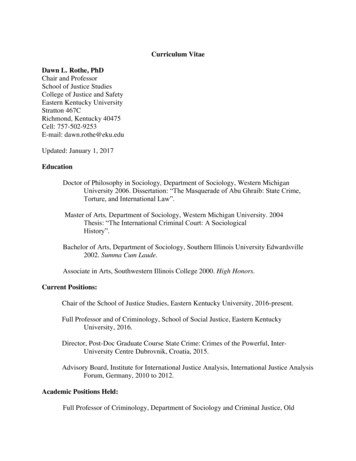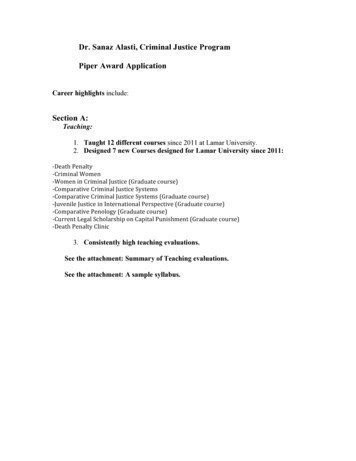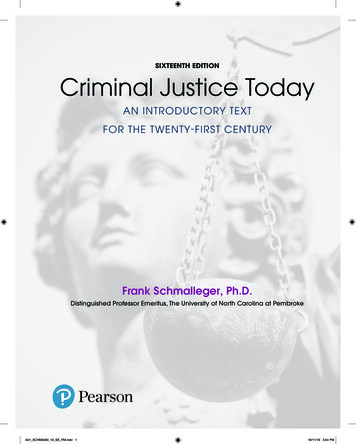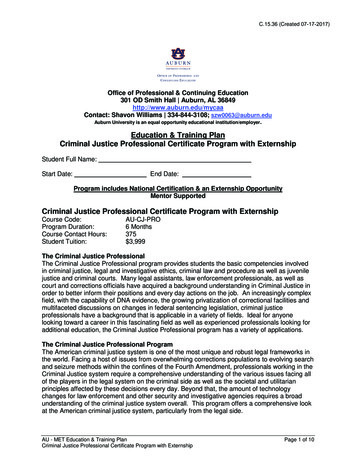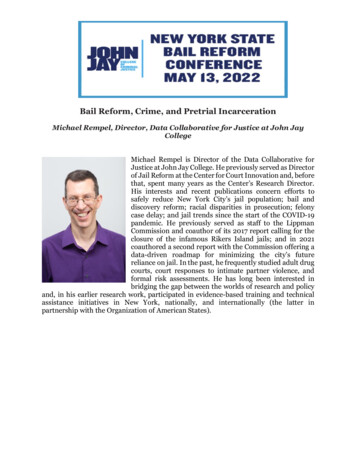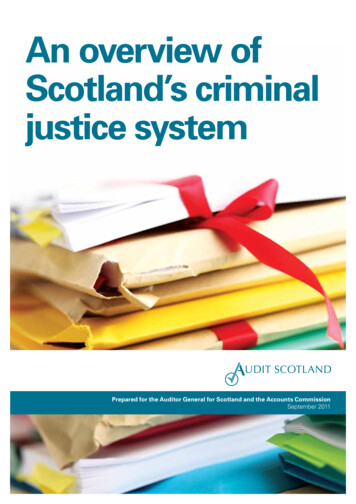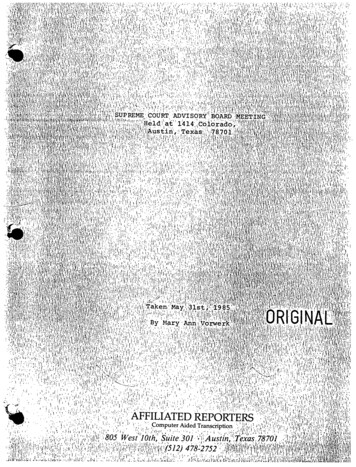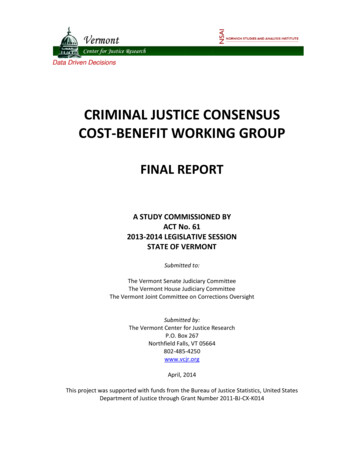
Transcription
Data Driven DecisionsCRIMINAL JUSTICE CONSENSUSCOST-BENEFIT WORKING GROUPFINAL REPORTA STUDY COMMISSIONED BYACT No. 612013-2014 LEGISLATIVE SESSIONSTATE OF VERMONTSubmitted to:The Vermont Senate Judiciary CommitteeThe Vermont House Judiciary CommitteeThe Vermont Joint Committee on Corrections OversightSubmitted by:The Vermont Center for Justice ResearchP.O. Box 267Northfield Falls, VT 05664802-485-4250www.vcjr.orgApril, 2014This project was supported with funds from the Bureau of Justice Statistics, United StatesDepartment of Justice through Grant Number 2011-BJ-CX-K014
CRIMINAL JUSTICE CONSENSUSCOST-BENEFIT WORKING GROUPFINAL REPORTA STUDY COMMISSIONED BYACT No. 612013-214 LEGISLATIVE SESSIONSTATE OF VERMONTSubmitted by:THE VERMONT CENTER FOR JUSTICE RESEARCHResearch TeamMax Schlueter, Ph.D., DirectorPrincipal InvestigatorRobin Weber, J.D., Ph.D., Research DirectorMarcia Bellas, Ph.D., Research AssociateWilliam (Travis) Morris, Ph.D., Research AssociateNathan Lavery, Joint Fiscal OfficeNancy Greenewalt, Joint Fiscal OfficeApril, 2014This project was supported with funds from the Bureau of Justice Statistics, United StatesDepartment of Justice through Grant Number 2011-BJ-CX-K014ACKNOWLEDGMENTS
The Vermont Center for Justice Research (VCJR) acknowledges the hard work, attention to detail,and collegiality of those who generously served as members of the Cost-Benefit Service DeliveryTeams and project consultants.Law Enforcement Service Delivery Team: Travis Morris, Coordinator, VCJRChief Michael Schirling, Burlington PDChief James Baker, Rutland PDChief Tony Facos, Montpelier PDChief Douglas Johnston, Springfield PDChief Robbie Blish, Woodstock PDChief George Merkel, Vergennes PDSheriff Keith Clark, Windham County Sheriff’s OfficeMajor William Sheets, Vermont State Police (VSP)Lt Brian Miller VSPJoanne Chadwick, Director of Administration/Finance, Department of Public Safety (DPS)Rick Hallenbeck, Assistant Director of Administration/Finance, DPSBetty Wheeler, IT Analyst/Spillman Administrator, DPSAdjudication Service Delivery Team: Robin Weber, Coordinator, VCJRThe Honorable Amy Davenport, Administrative Judge, Vermont Supreme CourtCarol Harrison, Chief Financial Officer, Vermont Court Administrator’s OfficeBram Kranichfeld, Executive Director, Department of State’s Attorneys and SheriffsSean Thomson, Department of State’s Attorneys and SheriffsJohn Treadwell, Criminal Division, Office of the Attorney GeneralMathew Valerio, Defender GeneralLora Evans, Business Manager, Office of the Defender GeneralDepartment of Corrections Service Delivery Team: Nathan Lavery, Nancy Greenewalt, and IraSollace, Coordinators, Legislative Joint Fiscal OfficeMonica Weeber, Director of Administrative Services, Department of Corrections (DOC)Sarah Clark, Finance Director, DOCDale Crook, Field Services Director, DOCScott Dubois, Assistant Superintendent, Northwest State Correctional Facility, DOCCheryl Elovirta, Field Services Operations Manager, DOCRick Byrne, Out-of-State Casework Supervisor, DOCDonna Pratt, Field Services Compliance Monitor, DOCThe many DOC staff members who provided input on time estimatesJuvenile Justice Service Delivery Team: Marcia Bellas, Coordinator, VCJRCheryle Bilodeau, Policy and Operations Manager/Juvenile Justice Director, Department forChildren and Families (DCF) -- Family ServicesElizabeth Stratton, Financial Manager I, DCF -- Business OfficeMargo Bryce, Quality Assurance Administrator, DCF -- Family Services DivisionJay Simons, Director, Woodside Juvenile Rehabilitation Center, DCF -- Family ServicesLindy Boudreau, Juvenile Justice Administrator, DCF -- Family ServicesNancy Williams, Revenue Enhancement Unit, DCF --Family ServicesLinda Moulton, Revenue Enhancement Unit, DCF -- Family Services
Victim Service Delivery Team: Max Schlueter, Coordinator, VCJRJudy Rex, Executive Director, Vermont Center for Crime Victim Services (VCCVS)Mary Kay Hewlett, Director of Victim Services, VCCVSCarol Morgan, Victim Compensation Program Manager, VCCVSElaine Boyce, Restitution Unit Program Manager, VCCVSProject ConsultantsAshleigh Holand, The Pew-MacArthur Results First Initiative, The Pew Charitable TrustsSteven Lize, Ph.D., consultant to The Pew-MacArthur Results First Initiative, The Pew CharitableTrusts
TABLE OF CONTENTSEXECUTIVE SUMMARY. 1INTRODUCTION . 1RESEARCH METHODS . 1CONCLUSIONS . 2RECOMMENDATIONS. 3THE LEGISLATIVE CHARGE . 5INTRODUCTION . 7BACKGROUND . 7OBJECTIVES . 7VERMONT RESULTS FIRST MODEL . 8RESEARCH METHODS . 9CALCULATING CRIMINAL JUSTICE COSTS . 10TYPES OF GOVERNMENT COSTS . 11HOW TO CALCULATE MARGINAL COSTS . 12DATA COLLECTION STRATEGIES . 12Law Enforcement Team . 12Adjudication Team . 15Department of Corrections. 20Juvenile Justice . 22Victims . 24COST ANALYSIS RESULTS: MARGINAL COSTS . 25COST ANALYSIS RESULTS: OPPORTUNITY COSTS. 29LAW ENFORCEMENT SERVICE DELIVERY TEAM . 30ADJUDICATION SERVICE DELIVERY TEAM . 30Courts. 30State’s Attorneys . 31Defender General . 32DEPARTMENT OF CORRECTIONS SERVICE DELIVERY TEAM . 32JUVENILE JUSTICE SERVICE DELIVERY TEAM . 33VERMONT CRIMINAL JUSTICE THROUGHPUT MODEL . 34VERMONT RESULTS FIRST MODEL: THE BENNINGTON COUNTY INTEGRATED DOMESTIC VIOLENCEDOCKET PROJECT . 42DATA QUALITY . 44TIME ANALYSIS DATA . 44THROUGHPUT MODEL DATA . 45VERMONT RESULTS FIRST MODEL . 46MANAGEMENT RESPONSIBILITY FOR THE COST-BENEFIT MODEL . 46CONCLUSIONS . 47RECOMMENDATIONS . 48
Criminal Justice Consensus Cost-Benefit Working Group ReportEXECUTIVE SUMMARYINTRODUCTIONPursuant to Act 61 this project had the following goals: 1) determine the costs of the criminal andjuvenile justice system including costs to victims; 2) develop “Throughput Models” 1 of the criminaljustice system to identify how cases proceed through the system and to serve as a tool to assessthe costs of policy changes; 3) analyze the cost benefits of the Bennington County IntegratedDomestic Violence Docket Project using the Results First Model 2; 4) assess the quality of justicedata collection systems for the purpose of conducting cost-benefit analysis; and 5) investigate theneed for and the most appropriate entity within state government to manage an ongoing criminaljustice cost benefit model.Given that the project was limited to approximately six months, the results reported in this reportshould be viewed more as a proof of concept than as a final product. All of the objectives set forthin Act 61 were accomplished. In some cases, however, costs associated with particularlycomplicated or highly-specific criminal and juvenile justice activities were more loosely estimatedor left unaddressed than would have been the case if there had been a longer study period. Withthat caveat in mind, the report provides a wealth of information regarding criminal and juvenilejustice costs and provides a firm foundation on which to base additional analysis.RESEARCH METHODSAct 61 directed the Vermont Center for Justice Research (VCJR) to manage the project. The VCJRadopted a collegial data collection and review model whereby agencies developed marginal andopportunity costs rather than using a “data collection by external expert” approach. Two WorkingGroups were established – the Executive Working Group and the Technical Working Group. TheExecutive Working Group was comprised of criminal and juvenile justice agency heads, and theTechnical Working Group was made up of financial managers and subject matter experts from theagencies named in Act 61. The Technical Working Group was further divided into Service DeliveryTeams, one for each criminal/juvenile justice function and one for victims. Each Service DeliveryTeam was assigned a staff coordinator either from VCJR or the Legislative Joint Fiscal Office (JFO).The Service Delivery Teams worked throughout the fall of 2013 to develop both marginal andopportunity costs for their respective duties. A marginal cost is the amount the total agencybudget changes when there is a small change in the workload of the agency. An opportunity cost isthe value of what could have been done with resources if they had not been committed to1A graphic which illustrates the flow of criminal cases through the criminal justice system together with theassociated opportunity costs.2The Pew-MacArthur Results First Initiative, a project of the Pew Charitable Trusts and the John D. andCatherine T. MacArthur Foundation (with additional support from the Annie E. Casey Foundation), workswith states to implement and customize an innovative cost-benefit analysis tool that helps them invest inpolicies and programs that are proven to work.1
Criminal Justice Consensus Cost-Benefit Working Group Reportsomething else. For example, when there are small reductions in a particular crime, the timewhich was devoted to handling that crime can be diverted to other activities within an agency.A statewide criminal and juvenile justice cost model was developed from the cost estimatesdeveloped by the teams. Service Delivery Teams were given the flexibility to develop datacollection methods appropriate to their service area. Staff coordinators, with the assistance oftechnical consultants from the Pew-MacArthur Results First Initiative, ensured that the researchmethods were valid and comparable between teams.The analysis of “benefits” in this cost-benefit project was based on the Vermont Results FirstModel. This model was developed by The Pew-MacArthur Results First Initiative based on workconducted by the Washington State Institute for Public Policy. Initial development of the VermontResults First Model for criminal justice services was undertaken by the Legislative Joint Fiscal Officewith assistance from the VCJR. The Vermont Results First model is a state-specific cost-benefit toolthat analyzes the costs and benefits of potential investments in evidence-based programs. Themodel incorporates Vermont criminal justice system costs, calculates program benefits associatedwith reduced system use and avoided victimizations within the state, and presents Vermontspecific return on investment statistics for individual programs and combinations of programs. Incompliance with Act 61, this report describes the methods used to calculate Vermont-specificcriminal justice costs for the cost-benefit model, reports findings of the cost analysis, provides acase study on the findings of the Vermont Results First model for the Bennington County DomesticViolence Docket, and provides recommendations for the continued use of the cost-benefit model.CONCLUSIONS1.The project demonstrated that a collegial research design utilizing the expertise of subjectmatter experts is a viable approach to developing: 1) valid cost models; 2) cost models which areunderstood by stakeholders; and 3) cost models which are endorsed by stakeholders.2.Analyses of marginal costs for the Vermont criminal and juvenile justice systems suggestthat only limited budget savings can be obtained by small reductions in crime. The researchdemonstrated that marginal cost savings are primarily accrued by reducing overtime and reducingservices that are provided by contracted services providers. Small reductions in crime will reducecosts to victims, an important consideration, but these savings do not accrue to the state budget.3.Planning and budgeting activities on the part of criminal/juvenile justice agencies canbenefit from the identification of opportunity costs. For example, when there are small reductionsin a particular crime, the time which was devoted to handling that crime can be diverted to otheractivities within an agency.4.Throughput Models of the Vermont Criminal/Juvenile Justice System based on analysis ofspecific crimes is a valuable tool for: 1) examining expenditures made by individualcriminal/juvenile justice agencies when processing crimes; and 2) identifying the overall taxpayerand victim costs of particular types of crime. Throughput Models can also be used as an importanttool to more accurately predict the cost of policy changes in criminal/juvenile justice.2
Criminal Justice Consensus Cost-Benefit Working Group Report5.The Vermont Results First model was demonstrated to be a useful tool for assessing thecost-benefit ratio of the Bennington County Integrated Domestic Violence Docket Project (IDVD)and other innovative corrections programs. The model determined that for every 1 invested inthe IDVD there is an expected long-term benefit of 1.89. Therefore, the IDVD program is costeffective.6.There is little in the way of electronic data to document the amount of time that criminaland juvenile justice professionals spend on their duties. One notable exception is the computeraided dispatch systems managed by the Department of Public Safety and other police departmentswhich track time-on-scene data for law enforcement personnel for particular crimes.7.Electronic data for the Throughput Models are maintained through cooperative dataexchange relationships between the Vermont Center for Justice Research and the Department ofPublic Safety, the Vermont Court Administrator’s Office, and the Department of Corrections. Withthe exception of arrest data from the Department of Public Safety, data quality is generally good.The Throughput Model could be made more robust if data exchanges also included State’sAttorneys and the Office of the Defender General whose management systems are currentlyinadequate for this purpose.8.The data systems at Vermont criminal/juvenile justice system agencies are sufficient at thistime to generate the requisite information to update and manage the Vermont Results First Model.The information was obtainable, but the process relied upon a considerable amount of manualwork on the part of agencies which is inefficient and costly. If legacy systems were replaced bymore technologically-advanced systems, data collection for the Vermont Results First model (aswell as other policy/research initiatives) would be more efficient, less costly, and probably moreaccurate.9.The Cost Benefit Working Groups concluded that the Vermont Results First criminal justicecomponent is a useful planning tool and the Vermont Center for Justice Research is best positionedto manage the criminal and juvenile justice sections of the model.RECOMMENDATIONSThe work accomplished by the Technical Working Group during the six months allotted to theproject is quite extraordinary. However, it is important to note that this is only the first iteration ofthe project. Given the important insights generated by the analysis, the Working Groupsrecommend continued development of the model consistent with the following points:1.The State of Vermont needs to reinvigorate its commitment to supporting evidence-basedprogramming in criminal and juvenile justice. It is essential that when new programs aredeveloped funding is earmarked for program evaluation. The costs associated with creating andmonitoring data systems for project management and evaluation are not trivial. If the State iscommitted to evidence-based planning and programing, adequate funding for these activitiesneeds to be provided. In particular resources should be available to evaluate projects in a mannerconsistent with the Vermont Results First model. The creation of valid evaluation data supports3
Criminal Justice Consensus Cost-Benefit Working Group Reportthe data-driven approach embodied in the Vermont Results First model and provides for a commonbasis upon which to assess program value.2.The Working Groups should revisit the marginal costs research undertaken during thisproject to identify step-wise marginal costs. Step-wise marginal costs occur when the total agencybudget changes because a certain workload or capacity threshold is reached -- for example, whenthe inmate population of a correctional center decreases enough to close an entire housing unit.This information is critical to understanding the impact that reductions in recidivism or changes incriminal/juvenile justice policy might have on the criminal/juvenile justice system.3.Since marginal and opportunity costs in criminal/juvenile justice are primarily driven bystaff costs, the importance of accurate time study data for various criminal/juvenile justice dutiescannot be overemphasized. Vermont criminal and juvenile justice agencies should work to identifyfinancial resources to support periodic time studies in order to maintain the validity of both thecriminal justice Throughput Model and the Vermont Results First model.4.The results of the opportunity cost analysis undertaken in this study should be madeavailable to criminal and juvenile justice agencies, and technical assistance should be provided toagencies who wish to develop strategies for including opportunity costs in their planning andbudgeting practices.5.Resources should be identified to make the Throughput Models a more robust tool forcriminal/juvenile justice planning at the state, regional, county, and local levels. In particular, theThroughput Model should be further developed to include intermediate sanction data and regularupdates to mirror changes in criminal and juvenile justice policy and practice.6.The State of Vermont should continue developing the Vermont Results First model as a wayto identify innovative programs that achieve a strong benefit-to-cost ratio. The Working Groupsnoted, however, that there are staff resource costs associated with developing the Vermont ResultsFirst model which include data collection (much of which is now manual) and analysis. Continuedeffort will require a major commitment from participating criminal/juvenile justice agencies as wellas the Legislature to be creative about finding resources to support the improvements intechnology and analysis methods required to support a robust cost-benefit analysis program inVermont state government.7.The responsibility for coordinating data collection, analysis, and updates of the VermontResults First criminal justice model component should be assigned to the Vermont Center forJustice Research (VCJR). VCJR should also be responsible for disseminating information developedfor the model to other state agencies for analysis.4
Criminal Justice Consensus Cost-Benefit Working Group ReportTHE LEGISLATIVE CHARGEAct 61Sec. 3. CRIMINAL JUSTICE CONSENSUS COST-BENEFIT WORKING GROUP(a)(1) A Criminal Justice Consensus Cost-Benefit Working Group is established to develop acriminal and juvenile justice cost-benefit model for Vermont for the purpose of providingpolicymakers with the information necessary to weigh the pros and cons of various strategies andprograms, and enable them to identify options that are not only cost-effective, but also have thegreatest net social benefit. The model will be used to estimate the costs related to the arrest,prosecution, defense, adjudication, and correction of criminal and juvenile defendants andvictimization of citizens by defendants.(2) The Working Group shall:(A) develop estimates of costs associated with the arrest, prosecution, defense,adjudication, and correction of criminal and juvenile defendants in Vermont by using the costbenefit methodology developed by the Washington State Institute for Public Policy and currentlyused collaboratively by the Joint Fiscal Office and the PEW Charitable Trust for the Vermont ResultsFirst Project;(B) estimate costs incurred by citizens who are the victims of crime by using data fromthe Vermont Center for Crime Victim Services, supplemented where necessary with national surveydata;(C) assess the quality of justice data collection systems and make recommendations forimproved data integration, data capture, and data quality as appropriate;(D) develop a throughput model of the Vermont criminal and juvenile justice systemswhich will serve as the basic matrix for calculating the cost and benefit of Vermont justice systemprograms and policies;(E) investigate the need for and the most appropriate entity within state government tobe responsible for:(i) revising the statewide cost benefit model in light of legislative or policy changes, orboth, in the criminal or juvenile justice systems;(ii) updating cost estimates; and(iii) updating throughput data for the model.(3) The Working Group shall be convened and staffed by the Vermont Center for JusticeResearch.5
Criminal Justice Consensus Cost-Benefit Working Group Report(4) The costs associated with staffing the Working Group shall be underwritten throughDecember 31, 2013 by funding previously obtained by the Vermont Center for Justice Researchfrom the Bureau of Justice Statistics, U.S. Department of Justice.(b) The Working Group shall be composed of the following members:(1) the Administrative Judge or designee;(2) the Chief Legislative Fiscal Officer or designee;(3) the Attorney General or designee;(4) the Commissioner of Corrections or designee;(5) the Commissioner for Children and Families or designee;(6) the Executive Director of State’s Attorneys and Sheriffs or designee;(7) the Defender General or designee;(8) the Commissioner of Public Safety or designee;(9) the Director of the Vermont Center for Crime Victim Services or designee;(10) the President of the Chiefs of Police Association of Vermont or designee;(11) the President of the Vermont Sheriffs’ Association or designee; and(12) the Director of the Vermont Center for Justice Research.(c) On or before November 15, 2013, the Working Group shall report its preliminary findings tothe Senate Committee on Judiciary, the House Committee on Judiciary, and the House Committeeon Corrections and Institutions. The Working Group shall issue a final report to the GeneralAssembly on or before January 1, 2014.6
Criminal Justice Consensus Cost-Benefit Working Group ReportINTRODUCTIONBACKGROUNDIn November 2011, Senate President Pro Tempore John Campbell and Speaker of the House ShapSmith jointly submitted a letter of invitation to the Pew-MacArthur Results First Initiative 3requesting help to “guide our thinking about our budget development system design.” Theycommitted to piloting the model in 2012 and designated the Legislative Joint Fiscal Office (JFO) tolead the implementation effort with “extensive Administration support and data assistance.”Over the last two years, the Vermont Center for Justice Research (VCJR) has been working with theJFO to develop a Vermont-specific cost-benefit model using the Results First approach. JFO andVCJR staff members have been trained in the cost-benefit methodology by staff from the PewMacArthur Results First Initiative (hereafter, Results First).Act 61 represents the continued interest by Vermont state government in the Vermont Results Firstmodel and the need to develop more detailed information regarding criminal justice costs. TheVCJR was able to secure partial funding for the work required under Act 61 from the Bureau ofJustice Statistics, U.S. Department of Justice.OBJECTIVESIn light of the legislative charge, the following objectives were developed to define and guide theproject:1.Develop both the opportunity and marginal costs for each phase of the Vermont Criminaland Juvenile Justice Systems to include the costs associated with arrest, prosecution, defense,adjudication, and corrections of both adult and juvenile offenders.2.Develop both opportunity and marginal costs for crime victimization to include taxpayerand victim costs.3.Develop Throughput Models of the criminal justice system using the offense typesidentified in the Results First model to identify how cases proceed from arrest through convictionand sentencing. This model combined with the marginal and opportunity costs identified abovewill provide a detailed cost model for criminal justice.4.Analyze the cost benefits of the Bennington Integrated Domestic Violence Docket using theVermont Results First Model which will include the criminal justice and victim costs developedabove.3The Pew-MacArthur Results First Initiative, a project of The Pew Charitable Trusts and the John D. andCatherine T. MacArthur Foundation (with additional support from the Annie E. Casey Foundation) works withstates to implement and customize an innovative cost-benefit analysis tool that helps them invest in policiesand programs that are proven to work.7
Criminal Justice Consensus Cost-Benefit Working Group Report5.Assess the quality of justice data collection systems and make recommendations forimproved data integration, data capture, and data quality as appropriate.6.Investigate the need for and the most appropriate entity within state government to beresponsible for: 1) revising the statewide criminal justice cost benefit model in light of legislative orpolicy changes, or both, in the criminal or juvenile justice systems; 2) updating cost estimates; and3) updating throughput data for the model.VERMONT RESULTS FIRST MODELThe Vermont Results First model is a state-specific cost-benefit tool that analyzes the costs andbenefits of potential investments in evidence-based programs. The model incorporates Vermontcriminal justice system costs, calculates program benefits associated with reduced system use andavoided victimizations within the state, and presents Vermont-specific return on investmentstatistics for individual programs and combinations of programs. This methodology is based on amodel developed by the Washington State Institute for Public Policy (WSIPP) and supported by thePew-MacArthur Results First Initiative (Results First) 4. The model is part of a larger approach toanalyzing budget choices based on the available evidence that programs and policies are effective.The Results First approach enables states to identify opportunities to invest limited funds togenerate both better outcomes for citizens and achieve substantial long-term savings. Vermont isone of a growing number of states that are customizing this approach to the state-specific contextand using its results to inform poli
The Vermont Center for Justice Research P.O. Box 267 Northfield Falls, VT 05664 802-485-4250 www.vcjr.org April, 2014 . Jay Simons, Director, Woodside Juvenile Rehabilitation Center, DCF -- Family Services Lindy Boudreau, Juvenile Justice Administrator, DCF -- Family Services

